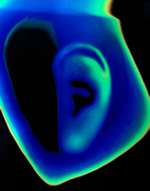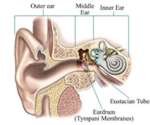Hearing loss, or deafness, is the partial or total inability to hear sound in one or both ears.

The
human ear is amazing. It is one of the smallest and most complex organs
in the body, capable of turning the tiniest disturbances in air
molecules into a form the brain can understand - and doing so
instantaneously, over an enormous range of pitch and loudness.
Considering the ear's delicacy, it is remarkably resilient.
Nevertheless, illness or injury can impair our ability to hear
properly.
In recent years, substantial advances have
made it possible to determine the cause of hearing impairment in nearly
all cases, and to treat the hearing loss in many ears.
About The Ear
The ear is divided into three major parts:
-
The outer ear
-
The middle ear
-
The inner ear

The outer ear has two parts:
-
The trumpet-shaped, protruding part of the ear on each side of the head, called the auricle or pinna
-
The tube leading into the ear, called the auditory canal; the opening is called the meatus

In the middle ear:

The eardrum (tympanic membrane) stretches across the inner end of the auditory canal.
The
middle-ear chamber is filled with air. There is an opening from the
middle ear to the throat through a tube called the eustachian tube. The
eustachian tube helps to equalize pressure on both sides of the eardrum.

A
chain of three small bones, called ossicles, connects the eardrum to
the inner ear. These bones are named for their shapes: the hammer,
anvil, and stirrup.

The inner ear is a fluid-filled chamber divided into two parts:
-
The vestibular labyrinth, which is the portion of the inner ear that functions as part of the body's balance mechanism.
-
The cochlea, which contains the hearing-sensing nerve.
The
cochlea is a hollow tube inside the inner ear that is coiled to
resemble a snail's shell. It contains thiin fluid and a highly
specialized structure called the organ of Corti, which contains
thousands of minute, sensory, hair-like cells. The organ of Corti
functions as the switchboard of the hearing system.
It is to the cochlea that sound vibrations picked up by the middle ear are carried.
The
acoustic nerve (also called the eighth cranial or auditory nerve) leads
from the inner ear to the brain, serving as the pathway for the nerve
impulses that the brain will interpret as sound.

How Do We Hear?
Hearing involves a complex chain reaction within the ear:
-
Sound creates vibrations in the air somewhat similar to the rippling waves created when a stone is thrown into a pond.
-
The outer-ear "trumpet" collects these sound waves, and they are funneled down the external ear canal to the eardrum.
-
As the sound waves strike the eardrum, they cause it to vibrate.
-
The vibrations are transmitted through the middle ear over the bony bridge formed by the hammer, anvil, and stirrup.
-
These
vibrations, in turn, cause the membranes over the openings to the inner
ear to vibrate, causing the fluid in the inner ear to be set in motion.
-
The motion of the fluid in the inner ear excites the nerve cells in the organ of Corti, producing electrochemical impulses that are gathered together and transmitted to the brain along the acoustic nerve.
-
As the impulses reach the brain, we experience the sensation of hearing.
The
sensitivity of the hearing mechanism is most extraordinary. With the
softest detectable sound, the eardrum only moves approximately
one-millionth of an inch. Our ability to detect sounds from the softest
to the loudest covers an intensity range of approximately 100,000,000
to 1.
What we hear are sound waves provided by
vibrations of air molecules. The size and energy of these waves
determine the loudness, which is measured in decibels (db). The number
of vibrations or cycles per second makes up frequency - the more
vibrations, the higher the pitch of the sound. Sound frequency is
expressed in cycles per second, or hertz (Hz).
Many
young, healthy humans (through teens and early twenties) can hear
frequencies from about 20 Hz to 20,000 Hz, and can detect frequency
differences as small as 0.2%. That is, we can tell the difference
between a sound of 1000 Hz, and one of 1002 Hz.
Consequently, it is no surprise that such a remarkably complex system can be damaged by various illnesses and injuries.
How Does Hearing Loss Affect One's Life?
Virtually
no condition in medicine can have as profound an effect on quality of
life as even moderate hearing loss in some people.
Hearing
loss makes even routine communication difficult. High frequency hearing
loss often involves loss of ability to hear consonants such as s, f, t,
and z, even though vowels can be heard normally. Consequently, people
hear but cannot make out what is being said.
This may
result in frustration, withdrawal from social activities, depression,
and marital discord. People lose the ability to take in the sounds like
bird songs, rustling of leaves, and the voices of children. In general,
these infringements on the quality of life can be overcome through
medical or surgical treatment or with hearing aids.
When
hearing loss occurs early in childhood, its devastating consequences
are more obvious than when it occurs late in life. A hearing deficit in
infants can interfere with psychological, emotional, and speech
development. It also makes learning a mammoth task and can cause
frustration or isolation.
Even more mild forms of
hearing loss early in life can cause great difficulties, including poor
attention and bad grades in school. Frequently, such children are
considered "not too bright," before anyone realizes that a hearing loss
is present. When it is corrected, the changes in the child's
performance, attitude, and interactions are often remarkable.
Facts About Hearing Loss
-
More than 40 million Americans have hearing loss.
-
Approximately 40% of the hearing-impaired are under age 65.
-
About 2 million children under age 18 are hearing-impaired in the U.S.
-
Minor decreases in hearing, especially of higher frequencies, are normal after age 20.
-
Some form of hearing loss affects 1 out of 5 people by age 55.
-
One-third of Americans between the ages of 65 and 74 - and one-half of those age 85 and older - have some form of hearing loss.
-
Hearing loss is the third leading chronic disability, following arthritis and high blood pressure.
-
Between 7 and 10 million people in American industry have noise-induced hearing loss, virtually all of which was preventable.
-
About
15% of college graduates have a level of hearing loss equal to or
greater than their parents; a significant cause is listening to loud
music.
-
In the U.S., 12 million people have hearing aids.
-
Of the 12 million with hearing aids, only 6 million actually wear them eight hours a day, seven days a week.
Source: http://health.yahoo.com/topic/hearing/overview/article/ehealthmd/Hearing_Loss_yms_HL_whatis